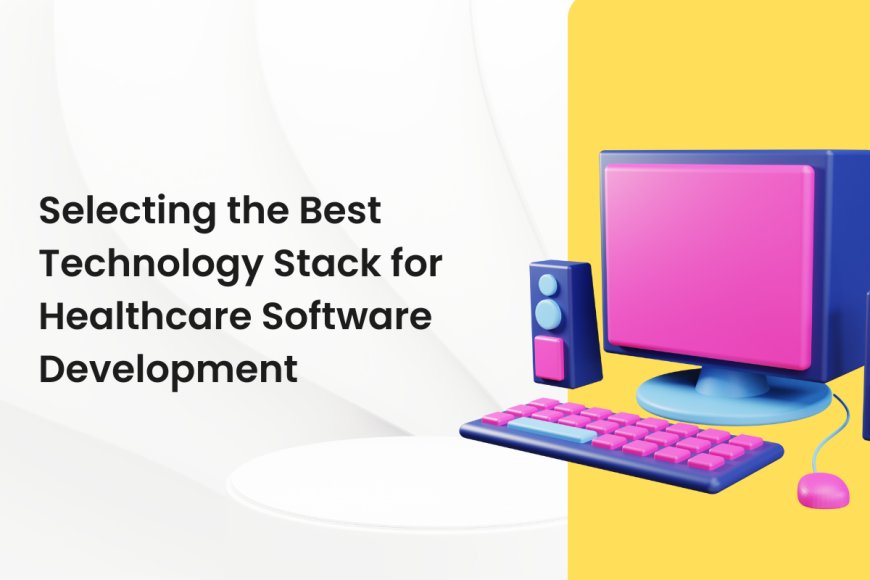Selecting the Best Technology Stack for Healthcare Software Development
Learn how to choose the best technology stack for healthcare software development. Explore key factors like security, compliance, scalability, and integration to build efficient and reliable healthcare solutions.

When it comes to developing healthcare software, selecting the right technology stack is a crucial decision that can significantly impact the functionality, security, and scalability of the software. The healthcare industry is unique in its needs and challenges, requiring solutions that can manage sensitive patient data, comply with strict regulations, and integrate with various healthcare systems. This article will guide you through the process of selecting the best technology stack for healthcare software development, highlighting key factors to consider and why each aspect matters.
What is a Technology Stack?
A technology stack refers to the combination of programming languages, frameworks, libraries, databases, and other tools used to build and operate software applications. The technology stack is essential because it determines how the software will function, how easy it will be to maintain, and how it will scale in the future. A well-chosen stack ensures that the software is reliable, efficient, and secure. In healthcare, the technology stack must also be capable of handling regulatory requirements like HIPAA (Health Insurance Portability and Accountability Act) and ensuring patient privacy and data security.
Note: If you are looking for reliable healthcare software development services, consider reaching out to Zenesys. They offer end-to-end healthcare software development solutions, ensuring that your software is secure, compliant, and efficient in delivering the best outcomes for your healthcare organization.
Making the right choice in technology will lay a strong foundation for your healthcare software, ensuring it remains efficient, scalable, and user-friendly in the years to come.
Why Selecting the Right Technology Stack is Important for Healthcare Software Development
The healthcare industry demands solutions that are robust, secure, and scalable. A wrong choice of technology can lead to a range of problems including slow performance, security vulnerabilities, and integration challenges. The primary reasons why selecting the best technology stack is important include:
-
Data Security and Privacy: Healthcare applications deal with sensitive patient data, making security a top priority. A good technology stack will have built-in security features to protect patient privacy, prevent unauthorized access, and ensure compliance with regulations such as HIPAA.
-
Compliance and Regulation: Healthcare software must comply with various regulations and standards. For instance, software used in healthcare must meet the standards set by government agencies, such as HIPAA in the United States. Using the right stack ensures the software meets these stringent requirements.
-
Integration with Other Healthcare Systems: Healthcare software often needs to communicate with other systems such as electronic health records (EHRs), pharmacy management software, and diagnostic systems. A technology stack that supports easy integration with these systems is essential for smooth operations.
-
Scalability and Performance: The healthcare industry is constantly evolving, and healthcare software must be able to scale with growing demand. A reliable stack ensures that the software can handle increased data and traffic as the healthcare facility or organization expands.
-
User Experience (UX): Healthcare software is used by a diverse group of people, including doctors, nurses, administrators, and patients. The user interface (UI) must be intuitive and user-friendly. A well-chosen technology stack can enable developers to create an interface that meets the needs of all users, ensuring seamless interactions.
How to Choose the Right Technology Stack for Healthcare Software
Selecting the best technology stack for healthcare software development involves several key steps. It is not just about choosing the most popular or the newest technologies. Here’s a step-by-step guide to help you make an informed decision:
1. Identify the Core Requirements of the Software
Start by defining the core features and functionalities your healthcare software needs to have. This could range from managing patient records to providing telemedicine services or integrating with laboratory equipment. The features will determine the type of technologies you will need. For example, if you’re building a mobile app, you’ll need technologies specific to mobile development, such as React Native or Swift.
2. Ensure Data Security and Compliance
Data security is paramount in healthcare software. Look for technologies that support secure data storage, encryption, and secure authentication protocols. For instance, technologies such as SSL/TLS encryption, OAuth2, and encryption libraries should be considered for secure data transmission and storage.
Moreover, ensure that your chosen technologies are compliant with relevant regulations such as HIPAA, GDPR (General Data Protection Regulation), and any other applicable data protection laws. You can also consider using cloud services that are HIPAA-compliant, such as Amazon Web Services (AWS) or Microsoft Azure.
3. Scalability and Performance
Healthcare software may need to handle large volumes of data, especially when dealing with patient records, diagnostic information, or real-time data from medical devices. Choose technologies that can scale easily and handle high performance under load. For example, using cloud-based solutions like AWS, Google Cloud, or Microsoft Azure provides scalability and flexibility.
Additionally, the choice of databases is critical. Consider using scalable databases like PostgreSQL, MongoDB, or MySQL that can handle large datasets and support fast retrieval of information.
4. Ease of Integration
Healthcare systems often need to integrate with other applications, such as Electronic Health Records (EHR), Hospital Information Systems (HIS), or third-party APIs for billing, payment, or appointment scheduling. Therefore, selecting a technology stack with good integration capabilities is crucial. RESTful APIs, for example, allow for easy integration with other systems. Moreover, technologies like GraphQL can offer more flexibility in managing data queries.
5. User Experience and Accessibility
In healthcare, usability is essential. Healthcare professionals and patients must be able to use the software without a steep learning curve. The technology stack should enable developers to create responsive and accessible interfaces, ensuring that all users can easily navigate the system, whether they’re tech-savvy or not.
Technologies like React for frontend development or Flutter for cross-platform mobile app development offer high-performance interfaces that are both functional and visually appealing. Additionally, accessibility features such as voice commands or larger text options can be important for improving patient and provider experiences.
6. Mobile Compatibility
With the rise of mobile health apps and telemedicine, your healthcare software may need to function across mobile devices. Consider using frameworks such as React Native or Flutter to develop cross-platform mobile apps. These frameworks enable faster development and ensure that the app works seamlessly on both Android and iOS platforms.
7. Select Reliable Frameworks and Libraries
Choose development frameworks and libraries that are well-supported and have a large community. For example, Angular, React, or Vue.js are popular frameworks for building web applications. These frameworks have a lot of resources, tutorials, and community support, making development easier and quicker.
Conclusion
Selecting the right technology stack for healthcare software development is a critical decision that impacts the security, scalability, compliance, and overall effectiveness of the software. By carefully considering factors such as data security, performance, integration capabilities, and user experience, you can ensure that your healthcare software meets the needs of both healthcare professionals and patients.
What's Your Reaction?


























